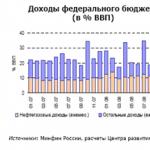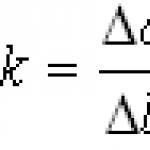Parallel parametric stabilizer, series stabilizer based on a bipolar transistor. Practical calculations.
Good afternoon, dear Radio Amateurs!
Today on the website ““, in the ““ section, we will continue to review the article ““. Let me remind you that last time, while studying the power supply circuit for amateur radio devices, we focused on the purpose and calculation of the anti-aliasing filter:
Today we will look at the last element - the voltage stabilizer.
Voltage regulator - an electrical energy converter that allows you to obtain an output voltage that is within specified limits when the input voltage and load resistance fluctuate
Today we will look at two simple voltage stabilizers:
- parallel parametric voltage stabilizer on a zener diode;
– serial voltage stabilizer on a bipolar transistor.
Semiconductor Zener diode - (another name is a Zener diode) is designed to stabilize the DC voltage of power supplies. In the simplest circuit of a linear parametric stabilizer, it acts as both a source of reference voltage and a power control element. In more complex circuits, it is assigned only the role of a reference voltage source.
One of the external views and designation of a zener diode:
How does a zener diode work?
The voltage to the zener diode (unlike the diode) is supplied in reverse polarity (the anode is connected to the minus and the cathode to the plus of the power source - Uarr). When turned on in this way, reverse current flows through the zener diode - Iobr.
As the voltage increases, the reverse current grows very slowly (in the diagram, almost parallel to the axis Uarr), but at some voltage Uarr the zener diode junction breaks through (but the destruction of the zener diode does not occur at this moment) and a reverse current of a much larger value begins to flow through it. At this moment, the current-voltage characteristic of the zener diode ( CVC) goes down sharply (almost parallel to the axis Iobr) – stabilization mode begins, the main parameters of which are the minimum stabilization voltage ( Ust min) and minimum stabilization current ( Ist min).
With further increase Uarr The current-voltage characteristic of the zener diode again changes its direction - the stabilization mode ends, the main parameters of which are the maximum stabilization voltage ( Ust max) and maximum stabilization current ( Ist max). From this moment, the zener diode loses its properties and begins to heat up, which can lead to thermal breakdown of the zener diode junction and, accordingly, to its failure.

The stabilization mode of a zener diode can be within wide limits, therefore the documentation for zener diodes indicates the permissible minimum and maximum current values ( Ist min And Ist max) and stabilization voltages ( Ust min And Ust max). Within these ranges lie those selected by the manufacturer nominal values – Ist And Ust. The rated stabilization current is usually set by manufacturers at 25%-35% of the maximum, and the rated value of the stabilization voltage is the average of the maximum and minimum.
For example, you can use the program “ “ and see with your own eyes what characteristics are given in reference books on zener diodes:

For example, a D814G zener diode:
- rated stabilization current (Ist) = 5 mA;
– nominal stabilization voltage (Ust) = (from 10 to 12 volts) = 11 volts;
– maximum stabilization current (Ist max) = 29 mA.
We will need this data when calculating the simplest voltage stabilizer.
If you could not find the required native, Soviet, zener diode, then you can use, for example, a program to select a bourgeois analogue according to the required parameters:

As you can see, the D814G zener diode can easily be replaced with an analogue - BZX55C11 (which has even slightly better characteristics)
Well, now let's look parallel parametric voltage stabilizer on a zener diode.
Parallel parametric voltage stabilizer on zener diode used in low-current devices (several milliamps) and is a voltage divider (on a resistor R– ballast resistor and zener diode VD– which acts as a second resistor) to the input of which an unstable voltage is supplied and the output voltage is removed from the lower arm of the divider. As the input voltage increases (decreases), the internal resistance of the zener diode decreases (increases), which allows the output voltage to be maintained at a given level. The difference between the input supply voltage and the stabilization voltage of the zener diode drops across the ballast resistor.
Let's consider the circuit of this (the simplest) voltage stabilizer:

For normal operation of the circuit the current through the zener diode should be several times (3-10 times) higher than the current in the stabilized load. In practice, since the rated stabilization current of the zener diode is several times less than the maximum, it is allowed to assume in calculations that the load current should not exceed the rated stabilization current.
Eg: the current consumed by the load is 10 mA, which means we need to select a zener diode such that its rated stabilization current is not less than 10 mA (it is better, of course, if it is larger).
Calculation of a parallel parametric voltage stabilizer using a zener diode
Given:
Uin– input voltage = 15 volts
Uout– output voltage (stabilization voltage) = 11 volts
Calculation:
1.
Using the reference book given above, we determine that the D814G zener diode is suitable for our purposes:
Ust(10-12v) = 11 volts
Ist max= 29 mA
Ist nominal = 5 mA
Based on the above, we determine that the load current should not exceed Ist nominal – 5 mA
2.
We determine the drop voltage across the ballast resistor (R) as the difference between the input and output stabilized voltage:
Upad=Uin – Uout=15-11= 4 volts
3.
Using Ohm's law, we determine the value of the ballast resistance R by dividing the drop voltage Udrop by Ist of the zener diode:
R= Up/Ist= 4/0.005= 800 Ohm
Since there are no resistors with a nominal value of 800 Ohms, we take the nearest higher value - R = 1000 Ohms = 1 kOhm
4.
Determining the power of the ballast resistor R:
Pres = Up*Ist= 4*0.005= 0.02 watts
Since not only the zener diode stabilization current flows through the resistor, but also the current consumed by the load, we increase the resulting value by at least 2 times:
Res= 0.004*2= 0.008 watts, which corresponds to the closest rating = 0.125 watts.
What to do if you haven’t found a zener diode with the required stabilization voltage.
In this case, you can apply series connection of zener diodes. For example, if we connect two D814G zener diodes in series, the stabilization voltage will be 22 volts (11+11). If we connect D814G and D810, we get a stabilization voltage of 20 volts (11+10).
Any number of series connections of zener diodes of the same series is allowed (as in the example - D8**).
Series connection of zener diodes of different series is allowed only if the operating currents of the series chain fall within the certified stabilization current ranges of each series used.
What to do if, in the above example, the load current is, for example, not 5 but 25 mA?
You can, of course, leave everything as it is, since the maximum stabilization current (Ist max) of the D814G is 29 mA, the only thing you have to do is recalculate the power of the ballast resistor. But in this case, the zener diode will work at the limit of its capabilities and you will not have any guarantees that it will not fail.
But what if the load current is, for example, 50 mA?
Series voltage regulator on a bipolar transistor- This is essentially a parallel parametric stabilizer on a zener diode connected to the input of the emitter follower.
Its output voltage is less than the stabilization voltage of the zener diode due to the voltage drop at the base-emitter junction of the transistor (for silicon transistors - about 0.6 volts, for germanium transistors - about 0.25 volts), which must be taken into account when choosing a zener diode.
An emitter follower (also known as a current amplifier) allows you to increase the maximum current of the voltage stabilizer compared to a parallel parametric stabilizer on a zener diode in β (h 21e) times (where β (h21e)– current gain of a given transistor, the smallest value is taken).
Circuit of a series stabilizer based on a bipolar transistor :

Since this stabilizer consists of two parts - voltage reference(aka parallel parametric stabilizer on a zener diode) and current amplifier on a transistor (also known as an emitter follower), then the calculation of such a stabilizer is carried out similarly to the above example.
The only difference:
- for example, we need to get a load current of 50 mA, then we select a transistor with a gain β (h 21e) at least 10 ( β (h 21e)=Iload/Ist=50/5=10
– the power of the ballast resistor is calculated using the formula: Рres=Upad*(Ist+Iload)
The load current can be increased several times more if you use a circuit with a composite transistor (two transistors connected according to a Darlington or Sziklai circuit):

 That's basically it.
That's basically it.
Calculation and design of a parallel stabilizer. Features of application. (10+)
Parametric parallel stabilizer
The principle of operation of a parametric parallel stabilizer is based on the fact that a fixed (or post-fixed) current is passed through it, specified by a current source (this is very good) or a resistor (this is a little worse). Next, the current is divided into two channels. Part of the current is directed to the load. The other part bypasses the load. The strength of the bypass current, and therefore the strength of the load current, is maintained such that the voltage across the load is equal to the specified value. Typical circuits of parallel stabilizers are shown in the figure.
Typical circuits of parallel parametric stabilizers
Unfortunately, errors are periodically found in articles; they are corrected, articles are supplemented, developed, and new ones are prepared.
Review of transformerless power supply circuits...
Heavy-duty switching audio amplifier. Squares. Broadcasting. Sound...
Heavy-duty pulsed sound amplifier for dubbing public events and other...
Thyristor turning on, turning off, switching, switching, switching...
Control of a thyristor power switch using an optocoupler. Galvanic isolation...
How to choose the controller operating frequency and duty cycle for a push-pull converter...
So, on the right is a diagram of a simple transistor voltage stabilizer.
Designations:
- Ik - collector current of the transistor
- I n - load current
- I b - transistor base current
- I R - current through the ballast resistor
- Uin - input voltage
- U out - output voltage (voltage drop across the load)
- U st - voltage drop across the zener diode
- U be - voltage drop at the p-n junction base-emitter of the transistor
How does such a stabilizer work and how does its work differ from the work? Yes, their work is almost no different - the voltage at the output of the circuit remains stable as a result of the presence of sections on the current-voltage characteristics (zener diode and p-n junction of the base-emitter transistor) in which the voltage drop weakly depends on the current. That is, like all parametric stabilizers, stability is achieved by the internal properties of the components.
Indeed, as can be seen from the figure, the voltage drop across the load is equal to the difference in the voltage drops across the zener diode and at the p-n junction of the BE transistor. Since the voltage drop across the zener diode weakly depends on the current (in the working section it is equal to the stabilization voltage), the voltage drop across the forward-biased p-n junction also weakly depends on the current (for a silicon transistor it can be taken approximately the same as for a conventional silicon diode - approximately 0. 6 Volts), it turns out that the output voltage is also constant.
Now let's add a little math.
Everything is clear with the load voltage (output voltage): U out =U st -U be, let's calculate R 0 and the area of normal operation of the stabilizer. But first, let’s draw two pictures side by side - a piece of the circuit of our stabilizer and a piece of the simplest parametric stabilizer on a zener diode:

It looks like it, doesn't it? Moreover, the reasoning and the relationships derived from them for calculating R0 and the normal operation area are also very similar.
The equation describing the currents and voltages for the piece of our stabilizer circuit torn out above:
U in =U st +I R R 0, taking into account that I R =I st +I b, we get
U in =U st +(I st +I b)R 0 (1)
For normal operation of the stabilizer (so that the voltage on the zener diode is always in the range from U st min to U st max), it is necessary that the current through the zener diode always be in the range from I st min to I st max. The minimum current through the zener diode will flow at the minimum input voltage and maximum base current of the transistor. Knowing this, we will find ballast resistor resistance:
R 0 =(U in min -U st min)/(I b max +I st min) (2)
If we take into account that in our case, when the transistor is connected according to a circuit with a common collector, the base current is related to the emitter current by the ratio I e = I b (h 21E +1), the emitter current is equal to the load current (because we have the load is turned on), and the voltage on the zener diode in operating mode changes slightly (instead of U st min, let’s just take U st), we get that
R 0 =(U in min -U st)/(I n max /(h 21E +1)+I st min) (3)
h 21E +1 is the current gain for a circuit with a common collector (h 21K), but since h 21E is usually quite large, the “+1” term is often thrown out and it is assumed that h 21K = h 21E, then the formula (3 ) becomes a little simpler:
R 0 =(U in min -U st)/(I n max /h 21E +I st min)
The maximum current through the zener diode will flow at a minimum transistor base current and a maximum input voltage. Taking this into account and what was said above regarding the minimum current through the zener diode, using equation (1) you can find the area of normal operation of the stabilizer:
Regrouping this expression, we get:
Or, in another way:
If we assume that the minimum and maximum stabilization voltage (U st min and U st max) differ slightly (the first term on the right side can be considered equal to zero), and also that I n =I e =I b h 21E (“+ 1" - throw it out), then equation describing the area of normal operation of the stabilizer, will take the following form:
This formula clearly shows the advantage of such a transistor stabilizer over a parametric stabilizer based on a zener diode - with all other parameters being equal, the output current of a transistor stabilizer can vary within a wider range.
For example, let’s again take the KS147A zener diode (I st = 3..53mA), and let’s estimate what maximum current we can expect when the voltage is reduced from 6..10V to 5V, provided that the output current can vary from zero to I max. Let's take the transistor KT815A (h 21E = 40). Having solved the system of equations (3), (4) together, we obtain R 0 about 110 Ohms and a maximum current of about 550 mA.
However, it is worth noting that the instability of the output voltage in this case will be even worse, since now the instability of the voltage drop at the p-n junction of the transistor will be added to the instability of the voltage on the zener diode. Plus, we have not yet taken into account that the output voltage will be less than on a zener diode by the amount of voltage drop across the p-n junction, so for good measure we would have to take a zener diode not at 4.7 V, but at 5.1 or even 5.6 Volt (I specifically took as an example the same zener diode as in so that it could be more clearly seen how the load current would differ with the same zener diode).
Actually, the methods of dealing with instability here are completely similar - you need to somehow reduce the instability of the voltage on the zener diode. To do this, you can, as last time, take a narrower working section of the I-V characteristic of the zener diode. This, naturally, will also lead to a narrowing of the area of normal operation (because the range of change in the operating current of the zener diode will decrease), but in this case, when the area of normal operation is already wider than that of a parametric stabilizer on a zener diode (about h 21E times), we are quite we can afford to give up part of the output current range and/or part of the input voltage range in order to increase the stability of the output voltage.

You can further increase the area of normal operation if you use two transistors connected according to a Darlington or Szyklai circuit (figure on the left). In this case, h 21E will be much larger.
Well, the most squeaking thing is to do, since the gain of the op-amp is not just greater, but significantly, much, many, many times greater than that of any transistor (accordingly, we will be able to change the current through the zener diode in an even narrower range, we will get an even smaller change voltage across it and, as a result, an even more stable output voltage).
There is another option - instead of a regular zener diode, you can take an integral zener diode, for example, TL431. In this case, in addition to significantly less instability, we also get the ability to regulate the output voltage.
For starters, I’ll say that with a slight movement of the hand, such a voltage stabilizer can be turned into a current stabilizer (you just need to stabilize the voltage not at the load, but at a special current-measuring resistor).
Content:Low-current circuits with loads of 20 mA or less use a low-efficiency device known as a parametric voltage regulator. The design of these devices includes transistors, stabilizers and zener diodes. They are used primarily in compensating stabilizing devices as reference voltage sources. Depending on the technical characteristics, parametric stabilizers can be single-stage, multistage or bridge.
The zener diode, which is part of the design, resembles a reverse-connected diode. However, reverse voltage breakdown, characteristic of a zener diode, is the basis for its normal functioning. This property is widely used for various circuits in which it is necessary to create a voltage limitation of the input signal. Parametric stabilizers are high-speed devices; they protect sensitive areas of circuits from impulse noise. The use of these elements in modern circuits has become an indicator of their high quality, ensuring stable operation of the equipment in various modes.
Parametric stabilizer circuit
The basis of a parametric stabilizer is a zener diode switching circuit, which is also used in other types of stabilizers as a source of reference voltage.
The standard circuit consists of, which, in turn, includes a ballast resistor R1 and a zener diode VD. The load resistance RH is connected in parallel with the zener diode. This design stabilizes the output voltage with changing supply voltage Up and load current In.
The circuit operates in the following order. The voltage increasing at the input of the stabilizer causes an increase in the current passing through resistor R1 and the zener diode VD. The voltage of the zener diode remains unchanged due to its current-voltage characteristic. Accordingly, the voltage across the load resistance does not change. As a result, all changed voltage will be supplied to resistor R1. The operating principle of the circuit makes it possible to calculate all the necessary parameters.
Calculation of a parametric stabilizer
The quality of operation of a voltage stabilizer is assessed by its stabilization coefficient, determined by the formula: KstU= (ΔUin/Uin) / (ΔUout/Uout). Next, the calculation of the parametric voltage stabilizer on the zener diode is carried out in accordance with the resistance of the ballast resistor Ro and the type of zener diode used.
To calculate the zener diode, the following electrical parameters are used: Ist.max - maximum current of the zener diode in the working section of the current-voltage characteristic; Ist.min - minimum current of the zener diode in the working section of the current-voltage characteristic; Rd - differential resistance in the working section of the current-voltage characteristic. The calculation procedure can be considered using a specific example. The initial data will be as follows: Uout= 9 V; In = 10 mA; ΔIн= ± 2 mA; ΔUin= ± 10%Uin.
First of all, the zener diode of the D814B brand is selected in the directory, the parameters of which are: Ust = 9 V; Ist.max = 36 mA; Ist.min= 3 mA; Rd= 10 Ohm. After this, the input voltage is calculated using the formula: Uin=nstUout, in which nst is the transfer coefficient of the stabilizer. The operation of the stabilizing device will be most effective when nst is 1.4-2.0. If nst = 1.6, then Uin = 1.6 x 9 = 14.4V.

The next step is to calculate the resistance of the ballast resistor (Ro). For this, the following formula is used: Ro= (Uin-Uout) / (Ist+In). The current value Ist is selected according to the principle: Ist ≥ In. In the case of a simultaneous change in Uin by the value ΔUin and In by the value ΔIn, the zener diode current should not exceed the values of Ist.max and Ist.min. In this regard, Ist is taken as the average permissible value in this range and is 0.015A.
Thus, the resistance of the ballast resistor will be equal to: Ro = (14.4 - 9) / (0.015 + 0.01) = 216 Ohm. The closest standard resistance will be 220 ohms. In order to select the desired type of resistor, you need to calculate the power dissipated on its body. Using the formula P = I2Ro, we obtain the value P = (25·10-3)2x220 = 0.138 W. That is, the standard power dissipation of the resistor will be 0.25W. Therefore, an MLT-0.25-220 Ohm ± 10% resistor is best suited for the circuit.
After completing all the calculations, you need to check whether the operating mode of the zener diode is selected correctly in the general circuit of the parametric stabilizer. First, its minimum current is determined: Ist.min = (Uin-ΔUin-Uout) / Ro - (In+ΔIn), with real parameters the value Ist.min = (14.4 - 1.44 - 9) x 103/ 220 is obtained - (10 + 2) = 6 mA. The same actions are performed to determine the maximum current: Ist.max = (Uin+ΔUin-Uout) / Ro - (In-ΔIn). In accordance with the initial data, the maximum current will be: Ist.max = (14.4 + 1.44 - 9) · 103/ 220 - (10 - 2) = 23 mA. If the obtained values of the minimum and maximum current are outside the permissible limits, then in this case it is necessary to change Ist or Ro. In some cases, the zener diode needs to be replaced.
Parametric voltage stabilizer on zener diode
For any radio-electronic circuit, a power source is required. They can be direct and alternating current, stabilized and unstabilized, and linear, resonant and quasi-resonant. This variety makes it possible to select power supplies for different circuits.

In the simplest electronic circuits, where high stability of the supply voltage or high output power is not required, linear voltage sources are most often used, which are characterized by reliability, simplicity and low cost. Their components are parametric voltage and current stabilizers, the design of which includes an element having a nonlinear current-voltage characteristic. A typical representative of such elements is a zener diode.
This element belongs to a special group of diodes operating in the reverse branch mode of the current-voltage characteristic in the breakdown region. When the diode is turned on in the forward direction from the anode to the cathode (from plus to minus) with a voltage Uthr, electric current begins to flow freely through it. If the reverse direction from minus to plus is turned on, then only a current Irev, amounting to only a few μA, passes through the diode. An increase in the reverse voltage on the diode to a certain level will lead to its electrical breakdown. If the current is sufficient, the diode fails due to thermal breakdown. Operation of a diode in the breakdown region is possible if the current passing through the diode is limited. In various diodes, the breakdown voltage can range from 50 to 200V.

Unlike diodes, the current-voltage characteristic of a zener diode has a higher linearity under conditions of constant breakdown voltage. Thus, to stabilize the voltage using this device, the reverse branch of the current-voltage characteristic is used. In the section of the direct branch, the operation of the zener diode occurs in exactly the same way as with a conventional diode.
In accordance with its current-voltage characteristic, the zener diode has the following parameters:
- Stabilization voltage - Ust. Depends on the voltage on the zener diode during the flow of current Ist. The stabilization range of modern zener diodes ranges from 0.7 to 200 volts.
- The maximum permissible direct stabilization current is Ist.max. It is limited by the maximum permissible power dissipation Pmax, which, in turn, is closely related to the ambient temperature.
- Minimum stabilization current - Ist.min. Depends on the minimum value of current passing through the zener diode. At this current, the device’s functionality should be fully preserved. The current-voltage characteristic of the zener diode between the parameters Ist.max and Ist.min has the most linear configuration, and the change in the stabilization voltage is very insignificant.
- Differential resistance of the zener diode - rst. This value is defined as the ratio of the increase in stabilization voltage on the device to the small increase in stabilization current that caused this voltage (ΔUCT/ ΔiCT).
Parametric transistor stabilizer
The operation of a parametric stabilizer using transistors is almost no different from a similar device using a zener diode. In each circuit, the voltage at the outputs remains stable, since their current-voltage characteristics affect areas with a voltage drop that is weakly dependent on current. That is, as in other parametric stabilizers, stable current and voltage indicators are achieved due to the internal properties of the components.

The voltage drop across the load will be the same as the difference between the voltage drop of the zener diode and the pn junction of the transistor. The voltage drop in both cases weakly depends on the current, from which we can conclude that the output voltage is also constant.
Normal operation of the stabilizer is characterized by the presence of voltage in the range from Ust.max to Ust.min. To do this, it is necessary that the current passing through the zener diode be in the range from Ist.max to Ist.min. Thus, the maximum current flow through the zener diode will be carried out under conditions of minimum transistor base current and maximum input voltage. Therefore, a transistor stabilizer has significant advantages over a conventional device, since the value of the output current can vary over a wide range.
As you know, no electronic device works without a suitable power source. In the simplest case, a conventional transformer and a diode bridge (rectifier) with a smoothing capacitor can act as a power source. However, a transformer for the required voltage is not always at hand. Moreover, such a power source cannot be called stabilized, because the voltage at its output will depend on the voltage in the network.
An option to solve these two problems is to use ready-made stabilizers, for example. They are convenient to use, but again they are not always at hand. Another option is to use a parametric stabilizer using a zener diode and a transistor. Its diagram is shown below.
Stabilizer circuit with 1 transistor
VD1-VD4 in this diagram is a regular diode bridge that converts alternating voltage from the transformer to direct voltage. Capacitor C1 smoothes out voltage ripples, turning the voltage from pulsating to constant. In parallel with this capacitor, it is worth installing a film or ceramic capacitor of small capacity to filter high-frequency ripples, because At high frequencies, the electrolytic capacitor does not do its job well. Electrolytic capacitors C2 and C3 in this circuit are used for the same purpose - smoothing out any ripples.
The R1 - VD5 chain serves to form a stabilized voltage, the resistor R1 in it sets the stabilization current of the zener diode. Load resistor R2. The transistor in this circuit absorbs the entire difference between the input and output voltage, so a decent amount of heat is dissipated on it. This circuit is not intended for connecting a powerful load, but, nevertheless, the transistor should be screwed to the radiator using heat-conducting paste.
The voltage at the output of the circuit depends on the choice of zener diode and the value of the resistors. Below is a table that shows the ratings of the elements to produce an output of 5, 6, 9, 12, 15 volts.

Instead of the KT829A transistor, you can use imported analogues, for example, TIP41 or BDX53. It is permissible to install any diode bridge that is suitable for current and voltage. In addition, you can assemble it from individual diodes. Thus, using a minimum of parts, a functional voltage stabilizer is obtained, from which other electronic devices that consume low current can be powered. Photo of the stabilizer I assembled.




















